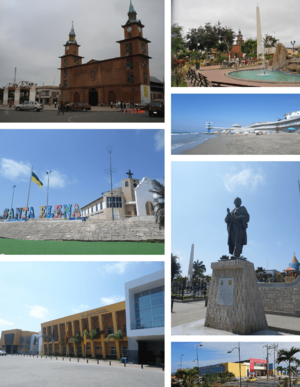Santa Elena, Ecuador facts for kids
Quick facts for kids
Santa Elena
|
||
|---|---|---|
|
Town
|
||

From top, left to right: Saint Helena Empress Cathedral, Vicente Rocafuerte Central Park, Ballenita beach, El Tablazo viewpoint, monument to Vicente Rocafuerte, City hall of Saint Helena and Sumpa Regional Bus station.
|
||
|
||
| Country | ||
| Province | Santa Elena | |
| Canton | Santa Elena | |
| Founded | 1531 | |
| Area | ||
| • Town | 19.48 km2 (7.52 sq mi) | |
| Elevation | 26 m (85 ft) | |
| Population
(2022 census)
|
||
| • Town | 54,565 | |
| • Density | 2,801.1/km2 (7,254.8/sq mi) | |
| Time zone | UTC-5 hours | |
| Climate | BWh | |
Santa Elena is a town in southwestern Ecuador. It is the main city of both the province and the canton that share its name. Santa Elena was first called Sumpa. It is located on the Ecuadorian coast, not far from the big city of Guayaquil. This town is famous for having the most important and well-studied ancient site in Ecuador.
Contents
Discovering Ancient Santa Elena
In 1977, a museum director named Olaf Holm asked archaeologist Karen E. Stothert to dig at an old site in Santa Elena. This site was from a time before people used pottery. Stothert and her team found proof of the Las Vegas culture. This was one of the first groups of people to live in Ecuador.
The Las Vegas Culture
The Las Vegas culture lived along the Ecuadorian coast from about 8,800 to 4,600 years before Christ. Archaeologists found many ancient tools and signs of homes. They even found an ancient trash pile. But the most exciting discovery was a burial ground. It held the remains of about 200 ancient people.
Why Santa Elena's Site is Important
Finding the ancient burial ground brought a lot of attention to Ecuador. It showed how important it is to study old sites. This helps us learn about history and culture. This attention has been good for Ecuador. It has brought in many visitors. The population of Santa Elena even doubled in 20 years.
Protecting the Past
For a while, there were some challenges in getting enough money to protect the site. But eventually, the team was able to secure it. This kept the old items safe. It also helped people learn about their culture. As Ecuador became more modern, some people moved away from their old ways. But this discovery, along with a great museum, helps keep the rich culture of the Las Vegas people alive.
Visiting the Site Today
The Santa Elena archaeological site is a major attraction on Ecuador's coast. In Ecuador, it is allowed to show ancient remains to the public. So, you can see three burials on display, protected by glass. Teachers and archaeologists, like Karen Stothert, use these displays to teach and help people learn.
The Sumpa Museum
In 1997, with proper funding, the Museo Amantes de Sumpa y Centro Cultural opened. This museum shows how private and public groups can work together. It is home to many items and remains from the Las Vegas culture. The site itself is a place for learning about heritage. It helps promote the culture of the native coastal Ecuadorians.
See also
 In Spanish: Santa Elena (Ecuador) para niños
In Spanish: Santa Elena (Ecuador) para niños



